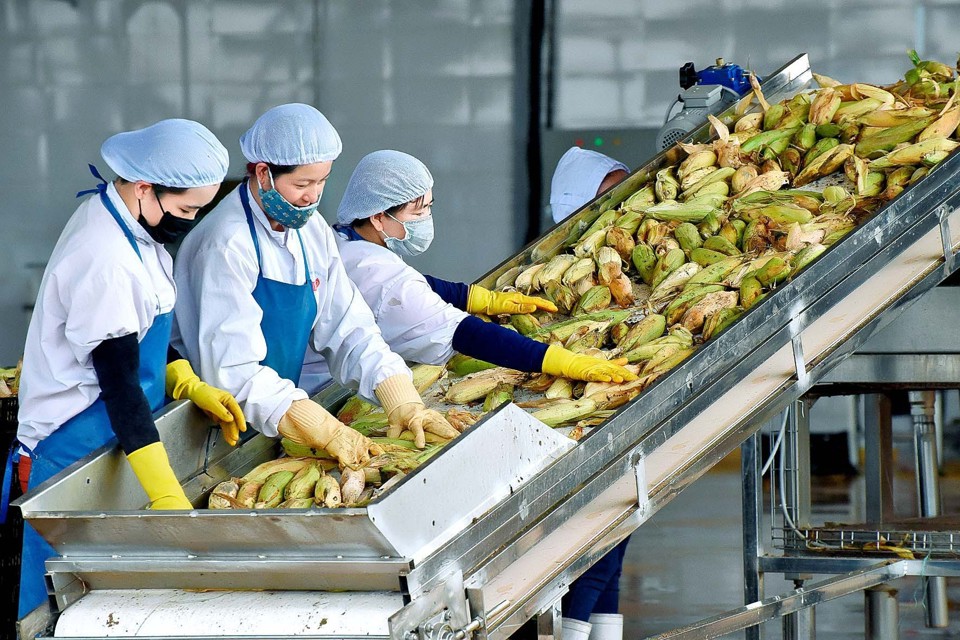Vietnam’s fruit exports gain momentum in early 2024
The export turnover is forecast to reach a record high of US$6.5 billion this year.
The value of Vietnam’s fruit exports in January reached US$510 million, up 24.9% compared to December 2023 and 112.1% against January 2023, according to the Ministry of Agriculture and Rural Development (MARD).
| Processing farm produce for export at Dong Giao Food Export Company. Photo: Duc Thuy/The Hanoi Times |
“In the context of ongoing economic challenges, this industry is proving to be a typical example of quick adaptation to market changes,” noted the ministry in a report.
Looking back at 2023, many types of fruit experienced surprising growth. A notable example is durian, whose exports in 2023 reached $2.2 billion, a 430.1% increase compared to the previous year.
Dragon fruit ranked second with an export value of $523 million, followed by bananas at $242 million jackfruit at $168 million, and mangoes at $154 million. Mangoes are also seen as having a strong potential for a breakthrough in the coming year. In recent years, only a small amount of mangoes have been exported, with the majority of this specialty fruit still being consumed domestically, indicating significant export potential.
The MARD suggested that with the achievements in 2023, the outlook for fruit exports in 2024 is very optimistic, as many types of Vietnamese fruits dominate large markets worldwide.
“It is projected that the export value of fruits in 2024 will exceed $6.5 billion,” it said.
The main factors driving the fruit industry toward achieving its goals in 2024 include: The demand in the largest fruit export market, China, remains high, and Vietnam is still negotiating with China to export more products directly to this market. Meanwhile, Vietnam continues to boost exports to major markets such as the US, EU, Australia, and South Korea.
On the issue of understanding market supply and demand, Minister of Agriculture and Rural Development Le Minh Hoan believes that Vietnam has moved to a market mechanism and therefore needs to change its mindset to keep up with the times.
"In the past, our approach involved meticulous annual planning of rice, chicken, eggs, and other produce, guided by a centralized management mindset. We calculated per capita consumption based on population and adjusted production accordingly. State intervention ensured that these quotas were met through state-owned enterprises and cooperatives. But now we've moved fully to a market-driven model, with global market integration,” Minister Le Minh Hoan highlighted the challenge of predicting global consumption trends, emphasizing the dynamic nature of the market.
"Nowadays, planning for agricultural products cannot be like it was in the past. Instead, based on market information through businesses - those closest to the market, each year we can use partners to provide a certain framework for us to guide people to produce according to market signals," he continued.
Regarding the mindset of building resource regions for production, Hoan believed that it was still necessary to build resource regions to a certain extent to at least ensure domestic consumption.
As for expansion, Hoan expected the country to find pathways, markets, and market signals that it could connect through bilateral or multilateral agreements, and agricultural and trade agreements with other countries to expand the world's consumption space, in addition to the domestic consumption space.
Vietnam's fruit and vegetable export turnover reached over $5.57 billion, marking a 65.6% increase compared to 2022.
The top 10 export markets for Vietnamese fruits and vegetables include China, the United States, South Korea, Japan, Thailand, the Netherlands, Taiwan (China), Australia, the United Arab Emirates, and Russia.
Particularly, China remained the largest importer of Vietnamese fruits and vegetables, with a value of $3.64 billion in 2023, representing a nearly 140% increase in value and a 65% increase in market share compared to the same period in 2022.











